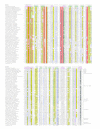MutL homologs in restriction-modification systems and the origin of eukaryotic MORC ATPases
- PMID: 18346280
- PMCID: PMC2292703
- DOI: 10.1186/1745-6150-3-8
MutL homologs in restriction-modification systems and the origin of eukaryotic MORC ATPases
Abstract
The provenance and biochemical roles of eukaryotic MORC proteins have remained poorly understood since the discovery of their prototype MORC1, which is required for meiotic nuclear division in animals. The MORC family contains a combination of a gyrase, histidine kinase, and MutL (GHKL) and S5 domains that together constitute a catalytically active ATPase module. We identify the prokaryotic MORCs and establish that the MORC family belongs to a larger radiation of several families of GHKL proteins (paraMORCs) in prokaryotes. Using contextual information from conserved gene neighborhoods we show that these proteins primarily function in restriction-modification systems, in conjunction with diverse superfamily II DNA helicases and endonucleases. The common ancestor of these GHKL proteins, MutL and topoisomerase ATPase modules appears to have catalyzed structural reorganization of protein complexes and concomitant DNA-superstructure manipulations along with fused or standalone nuclease domains. Furthermore, contextual associations of the prokaryotic MORCs and their relatives suggest that their eukaryotic counterparts are likely to carry out chromatin remodeling by DNA superstructure manipulation in response to epigenetic signals such as histone and DNA methylation.
Figures


References
-
- Watson ML, Zinn AR, Inoue N, Hess KD, Cobb J, Handel MA, Halaban R, Duchene CC, Albright GM, Moreadith RW. Identification of morc (microrchidia), a mutation that results in arrest of spermatogenesis at an early meiotic stage in the mouse. Proc Natl Acad Sci U S A. 1998;95:14361–14366. doi: 10.1073/pnas.95.24.14361. - DOI - PMC - PubMed
Publication types
MeSH terms
Substances
Grants and funding
LinkOut - more resources
Full Text Sources
Molecular Biology Databases

